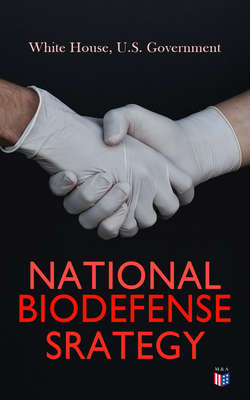Читать книгу National Biodefense Strategy - White House - Страница 8
Biological Risk Management
ОглавлениеBiological risk management requires understanding and assessing biological risks, and taking steps to prepare for, prevent, and respond to them, regardless of whether they originate in the United States or abroad. It also requires shared international recognition that the risk is global to empower effective, collective mitigation. In our interconnected world, it is not if, but when, the next biological incident will occur.
As the biological threat continues to evolve, so must our biodefense capabilities. If all countries could prevent, detect, and respond to infectious disease outbreaks at the local level, we can minimize the risk of global health emergencies, saving both lives and resources. Preventing acquisition of dangerous pathogens, equipment, and expertise for nefarious purposes, and maintaining the capability to rapidly control outbreaks in the event of a biological attack, are strategic interests of the United States. These must be strategic interests for partners around the world as well. The United States cannot carry the burden alone. Finally, as we reap the benefits from biotechnologies, we must also understand and consider the risks they may pose. The United States will pursue an efficient and coordinated biodefense enterprise to protect the American people.
Domestic action alone is insufficient to protect America’s health and security. The rapid globalization of science and technology and the interconnectedness of travel and trade necessitate a strong biodefense enterprise that has global reach to effectively prevent, detect, and respond to biological incidents. The United States Government works at home and abroad to ensure that the United States and its partners are protected from natural, accidental, or deliberate biological threats. While the desired outcomes at home and abroad are the same, the conditions and avenues available to achieve these outcomes can be very different. Internationally, our efforts to protect the United States and our partners include direct investment in sustainable, context-appropriate capacity building that leads to selfreliance. We will work with multilateral organizations, partner nations, private donors, and civil society to control disease outbreaks at their source by supporting the development and implementation of biodefense and health security capabilities, policies, and standards.
The United States has long been an innovation leader. Whether augmenting our ability to provide health care and protect the environment, or expanding our capacity for energy and agricultural production towards global sustainability, continued research and development in life sciences is essential for a brighter future for the American people. To ensure that the United States is poised to meet the evolving biological risk landscape, at a time when unparalleled advancement and innovation in the life sciences globally continue to transform our way of life, we are committed to promoting innovation throughout the national biodefense enterprise. We will promote innovative technologies and systems; encourage innovative technology communities and industry leaders to meet our targeted biodefense and health capacity needs; link stakeholders with new ideas, tools, and products; and pursue innovative approaches and partnerships to achieve, at home and abroad, the desired goals articulated in this National Biodefense Strategy.
Through the National Biodefense Strategy, the United States will use all appropriate means to assess, understand, prevent, prepare for, respond to, and recover from biological incidents— whatever their origin—that threaten national or economic security. The National Biodefense Strategy recognizes that a collaborative, multisectoral, and trans-disciplinary approach to the national biodefense enterprise is necessary to counter biological threats effectively and efficiently.
